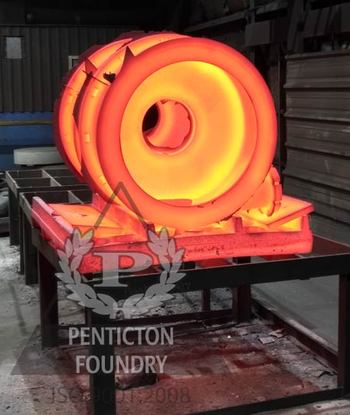How to Heat Treat ASTM A532 – High Chrome White Iron
on January 16, 2018Why Use Chrome White Iron
ASTM A532, or high chrome white iron, has superior abrasion resistance. It is particularly effective in machinery or equipment that experiences grinding, gouging abrasion or crushing. It can significantly reduce downtime and outlasts AR plate and CCO (by as much as 20 times in the case of CCO) in abrasion resistant applications.
Case Study: Read this case study for a specific example of chrome white iron outperforming AR plate.
Microstructure Notes
No article on heat treating ASTM A532 would be complete without taking a look at its microstructure.
The high level of chromium in high chrome white iron prevents the formation of graphite in the microstructure. Instead of graphite, the carbon in the metal becomes tied up in carbides. These relatively discontinuous chromium-rich, eutectic carbides exist with martensite to make up the microstructure. By controlling the chemistry of the metal and the heat treatment of the castings, toughness and wear resistance can be designed to provide the best end-product for many abrasive applications.
Heat Treatment Tips and Notes for ASTM A532
Austenitization
Austenitization must be done to castings made from chrome white iron to ensure a martensitic matrix and provide the highest toughness and abrasion resistance possible.
- The chemical composition of the casting will determine the correct austenitizing temperature and time. A temperature that is too high or low will adversely affect the microstructure (retained austenite or low-carbon martensite), resulting in lower hardness and lower abrasion resistance. The correct time at temperature must also be followed, or final properties will be affected.
- The second part of austenitizing is air quenching. This is an important step that promotes a martensitic matrix. The chemical composition of the casting will determine the amount of time needed to cool the casting to below the pearlite-temperature range.
Pro Tip: If cooled too quickly, the microstructure will contain pearlite and will not be as hard or abrasion resistant. It may also promote cracking. Once below the pearlite-temperature range, it is important to stop aggressive air quenching. At this stage, the casting should be cooled in still-air, or even put back into a warm furnace and allowed to furnace-cool to room temperature. This is because the martensite transformation begins at a temperature below the pearlite-temperature and the casting undergoes a lot of stress during this transformation.
Tempering
Tempering may restore some toughness to the martensitic matrix and relieve residual stresses.
Annealing
Annealing is a way to soften the casting by converting the microstructure to pearlite. This would be done to soften the casting for some machining operations.
Common Problems with Incorrect Heat Treatment of ASTM A532
- Casting is too soft – This can be caused by incorrect chemistry, improper austenitizing temperature/time, or improper quenching technique. Perhaps the casting was annealed for machining and then not hardened properly.
- Casting is too hard for some machining operations – This can be the result of incorrect chemistry or improper annealing.
- Casting is experiencing spalling – This can be caused by incorrect chemistry, improper austenitizing temperature/time, or an improper quenching technique. The theory is that retained austenite above a certain level will contribute to spalling.
- Improper hardness – Using a furnace that does not provide accurate and uniform temperatures can cause this effect.
- Cracked Casting – If you do not heat or cool the casting at the correct rate it can crack. Cracks can also be formed during or right after solidification as a result of poor foundry practice. Cracking/tearing can also be influenced by chemistry.
Parts Ideally Suited to ASTM A532
- Gyratory crusher liners
- Chute liners
- Mill liners
- Cyclones
- Pump parts
- Piping components such as wyes, laterals, reducers and elbows
- Hydraulic fracturing components

